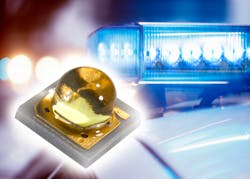The Oslon signal LED uses thin-film chip technology and emits bright blue light, providing signal lighting for police and emergency vehicles. It has luminous flux of 52 lm at 350 mA, at 472 nm, and complies with US and EU standards. The LED measures 3 × 3 mm and is equipped with an electrically isolated heat slug.
Osram Opto Semiconductors
Sunnyvale, CA
www.osram-os.com
More Products
-----
PRESS RELEASE
New Oslon Signal provides bright blue light for emergency vehicles
Osram Opto Semiconductors’ new LED enhances visibility of emergency vehicle lighting
Osram Opto Semiconductors’ new Oslon Signal LED currently provides the world’s brightest blue light. Made using a special thin-film chip technology, the Oslon Signal emits powerful bright blue light providing significantly brighter signal lighting to enhance the visibility that is so critical for police and emergency services vehicles. The Oslon Signal can be operated at a high current and provides steady brightness even in the most demanding applications.
The Oslon Signal produces a blue color at an unprecedented brightness level, with a luminous flux of 52 lumens (lm) at 350 milliamperes (mA). Its wavelength of 472 nm and all color bins (groups) comply perfectly with the US and EU standards for signaling, particularly for Emergency Vehicle Lighting. The package platform of the Oslon family, consisting of a ceramic substrate with built-in connecting contacts and a silicone lens, remains stable and resistant to aging caused by the short-wave blue light.
Double the increase in brightness
The Oslon Signal incorporates high-performance UX:3 chips, which are capable of operating at very high performance levels even at extremely high currents. This is an important aspect, as blue signal light is often pulsed and therefore requires even greater luminous power at high currents. Despite its powerful output, the LED measures only 3 x 3 mm and is equipped with an electrically isolated heat slug, so it can be mounted easily and conveniently in combination with a conventional FR4 board. The lens has a radiation angle of 80° and provides a highly symmetrical light output. The Oslon Signal can also be easily mounted in existing emergency vehicle lighting applications to provide significantly brighter signal lighting.
“Our development team has succeeded in a very short time in doubling the brightness of blue LEDs, resulting in our being able to offer the world’s brightest product in this sector,” said Jennifer Rieder, Marketing Manager at Osram Opto Semiconductors. “It significantly contributes to greater road safety, as emergency vehicles can be seen sooner and better.”
In addition to blue LEDs, the Oslon family of LEDs includes a variety of other colors such as red, yellow, green and white, which all use the latest thin-film chip technologies, making them particularly effective in a broad range of applications including emergency vehicle lighting, auxiliary signaling, warning beacons and other similar applications.
Specifications:
LED dimensions: 3x3 mm
Luminous flux: typ. 52 lm at 350 mA
Wavelength: 472 nm
Radiation angle: 80°
Standards:
USA: SAE, ICAO
Europe: CIE S004/E-2001, DIN 6163-1, RL65
http://www.osram-os.com/pr-OSLON_Signal
ABOUT OSRAM OPTO SEMICONDUCTORS
OSRAM AG (Munich, Germany) is a wholly-owned subsidiary of Siemens AG and one of the two leading lighting manufacturers in the world. Its subsidiary, OSRAM Opto Semiconductors GmbH in Regensburg (Germany), offers its customers solutions based on semiconductor technology for lighting, sensor and visualization applications. Osram Opto Semiconductors has production sites in Regensburg (Germany) and Penang (Malaysia). Its headquarters for North America is in Sunnyvale (USA), and for Asia in Hong Kong. Osram Opto Semiconductors also has sales offices throughout the world. For more information go to www.osram-os.com.
-----
Follow us on Twitter
Subscribe now to Laser Focus World magazine; it's free!
